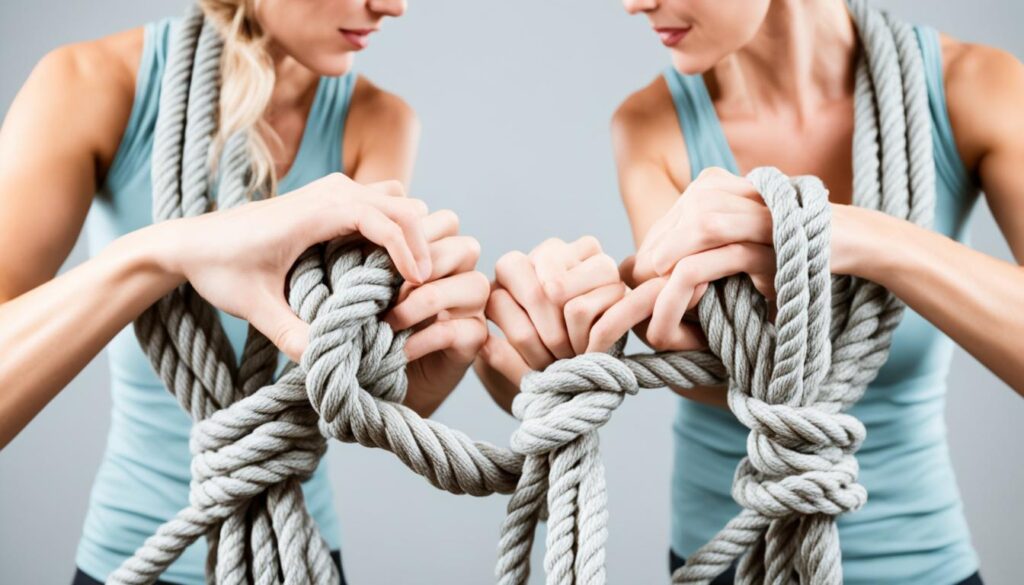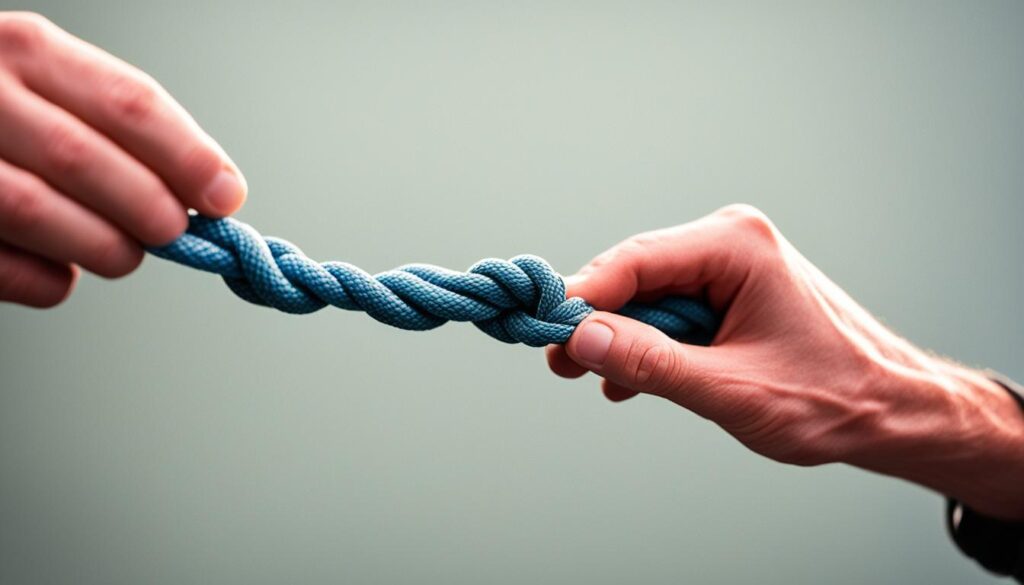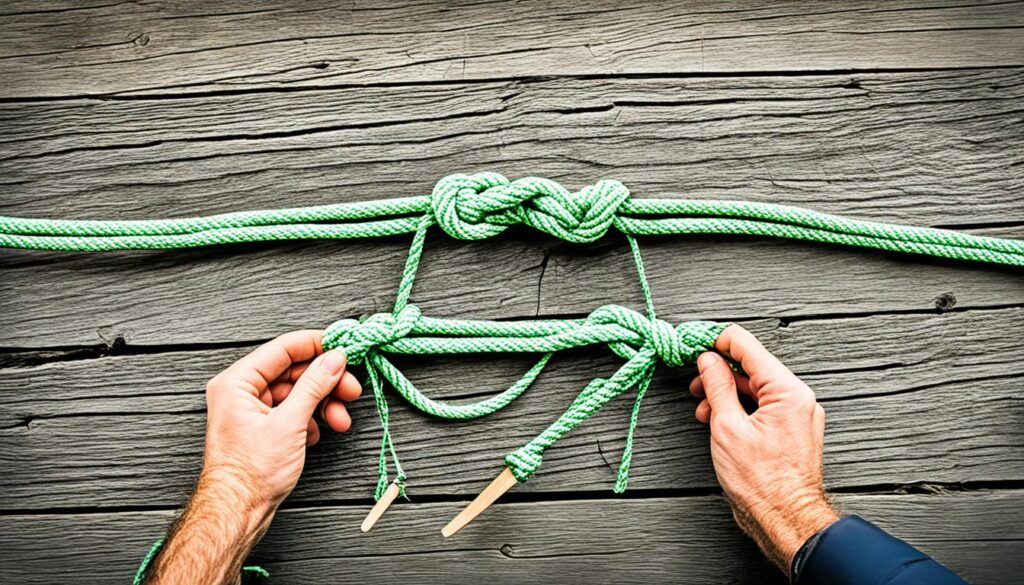Want to improve your fishing knot-tying game? You’re in the right spot. This guide will walk you through the step-by-step process of learning how to tie the J-Knot. It’s a top choice for connecting fluorocarbon to braid. Using Saltwater Experience’s video tutorial, you’ll get the J Knot down pat in no time.
Angler’s Essentials:
- Learn to tie the J-Knot, a reliable knot for joining fluorocarbon to braid.
- Follow Captain Tom Rowland’s step-by-step video guide to master the j Knot quickly.
- Understand the J-Knot’s benefits, including its strength and smooth ramp design.
- Discover the various applications of the J-Knot in both saltwater and freshwater fishing scenarios.
- To ensure a secure connection, you can avoid common mistakes when tying the J-Knot.
Understanding the J Knot
The J-Knot is a favorite among anglers for connecting lines. It combines a uni knot with the fluoro and an improved clinch knot with the braid. This mix makes a strong link and is excellent for many fishing needs. Anglers like it because it is easy and reliable. The braid forms a small, smooth ramp, making it easy to pass through rod guides.
To tie a J-Knot, start with a uni knot on the fluoro leader. Pass it through the hook’s eye and make a loop with the long end. Wrap it around the mainline and the short end, then pass it through this loop twice. Moisten it and tighten it by pulling both ends.
Then, make an improved clinch knot with the braid. Put the braid through the hook’s eye and make a loop with it. Wrap the free end around the doubled line five to seven times. Pass the free end through the loop, moisten the knot, and tighten by pulling both ends.
Remember to trim any excess line after tightening the knots. This ensures a neat setup.
The J-Knot has key benefits for anglers. It’s easy to learn and provides a strong connection. This is important when you need both fluoro and braid. The smooth ramp helps the line move through rod guides quickly. Anglers love it for its outstanding performance in fishing.
Knowing the J-Knot well improves your fishing skills. It lets you securely link the j knot braid to fluorocarbon.
Step-by-Step Guide to Tying the J Knot
Want to learn the J-Knot from scratch? Captain Tom Rowland is here to help. Check out his detailed video tutorial. You’ll go from the uni knot with fluorocarbon to the clinch knot with braid. With his help, you’ll nail the J-Knot quickly and easily.
I think following a video tutorial for the J-Knot is crucial. It’s a knot that needs specific steps to be solid and safe. The video tutorial gives clear directions and shows every step. This way, everything is clear.
First, could you get your fluorocarbon, braid, and tools ready? This might include pliers or nail clippers. Pay close attention to the video. Captain Tom explains each step clearly.
“The J-Knot is perfect for linking fluorocarbon and braids. It’s tough, smooth, and secure,” says Captain Tom Rowland.
Keep an eye out for Tom’s special tips. These pointers can boost your J-Knot’s quality.
Remember, practice is key. Spend some time perfecting your J-Knot. This will boost your confidence and make it quick and easy to tie whenever you need to.
Ready to dive in? You can start with Tom’s video tutorial. It’s great for both new and seasoned anglers. You’ll learn to tie the J-Knot like a true professional.

Benefits of the J-Knot
The J-Knot is loved by anglers worldwide for several reasons. It creates a strong and reliable connection between fluorocarbon leaders and braided lines. This is a big deal, especially when you’re going after fish that need both line types. With the J-Knot, you can fish without worrying if your gear will hold up.
One cool thing about the J-Knot is how it makes a small and smooth ramp with the braid. This design helps the knot move smoothly through the guides on your fishing rod. No rough edges mean it’s easier to catch big fish without the line breaking or tangling.
Tying the J-Knot is also super simple. Anyone, no matter their fishing skill, can learn it fast. This makes fishing more about the fun and less about struggling with knots. Anglers can enjoy their time on the water without knot-tying worries.
Thanks to its secure and easy-to-learn design, the J-Knot is a must-have for anglers. It’s an easy and strong way to join different fishing lines, and this knot might just make your next fishing trip a whole lot better.
Applications of the J-Knot
The J-Knot is perfect for many fishing needs. People who fish for big fish like sailfish or bass trust the J-Knot. It’s excellent for using braided lines and fluorocarbon together.
“The J-Knot is key to my fishing gear,” says Mark Stevens from Florida. “It securely links my braided line to fluorocarbon leaders.”
It’s awesome for fishing in the ocean or the lakes. The J-Knot makes sure your lines stay together. It works well if you fish from a boat or the shore.
J-Knot Demonstration
Check out this video to learn how to do the J-Knot. See it in action with real fishing.
By watching and learning from this video, you can tie the J-Knot like a pro. It will become a must-have skill for all your fishing needs.
Tips for Tying the J-Knot
To tie a strong J-Knot, remember a few key tips. These tips will help you tie it right. You’ll be sure it’s strong and won’t let you down.
Wet the Knot Before Tightening
It’s smart to wet the knot before making it tight. This lowers friction and keeps the heat down. Wetting the knot keeps it solid and reliable, even in water sports.
Follow the Step-by-Step Process
Tying a J-Knot well means taking it step by step. A good video tutorial can show you how. Follow the steps closely for a tight, reliable knot.
“Following the step-by-step process is crucial for achieving a secure and effective J-Knot.”
Practice Makes Perfect
Remember to practice before going fishing. Practicing will make you quick and accurate at tying the J-Knot, which is valuable when fishing gets tough.

Common Mistakes to Avoid
When learning to tie a J-Knot, watch out for mistakes. These errors can weaken the knot. To make sure your J-Knot holds, remember these tips:
- Not fully tightening the knots can cause them to slip. It might even lead to the knot breaking. So, could you make sure to tighten them well?
- It’s vital to tie the J-knot correctly. Doing it wrong by overwrapping or crossing lines can weaken the knot, which means it might not hold. Always double-check that you’re following the steps correctly.
- Wetting the knot reduces friction, helping prevent damage and making the J-Knot last longer. Remember to wet the knot with water or saliva before tightening.
Knowing these mistakes and being careful helps you tie better J-Knots. This can improve your fishing outcomes.
Remember:
“A properly tied J-Knot is the key to a secure connection between fluorocarbon leaders and braided lines. Take your time, follow the instructions carefully, and avoid these common mistakes to ensure a reliable knot.”
With these tips on errors to dodge, let’s explore the perks and ways to use the J-Knot in the following parts.
Conclusion
The J-Knot is a super helpful knot for people who fish. It’s great for connecting your fishing line. This knot is simple, strong, and lasts a long time. It’s a must-know for anyone into fishing. With a few tries, you’ll be an expert in no time.
It’s perfect for catching fish in lakes or oceans. Use this knot whether you’re after bass or big fish like sailfish or snook. It’s easy for anyone to learn. No more stress about your line breaking.
The J-Knot is changing how anglers fish. It’s strong, long-lasting, and easy to do. So, I want you to please be sure to wait. Learn the J-Knot today. Enjoy fishing without worrying about your line. Get ready to catch some fish!
FAQ
What is the J-Knot?
The J-Knot is a quick and strong way to connect fluorocarbon to braid lines. It takes parts of the uni and clinch knots to make a solid tie.
How do I tie the J-Knot?
First, make a uni knot with the fluorocarbon. Then, could you do an improved clinch knot with the braid? Saltwater Experience has a helpful video to show you how.
What are the benefits of the J-Knot?
The J-Knot makes a tough link between braid and fluorocarbon. It creates a small ramp, helping the line glide smoothly. It’s easy to do and works well.
Where can I use the J-Knot?
You can use the J-Knot for many fishing types, like freshwater or saltwater. It’s good for catching largemouth bass, tarpon, sailfish, and more.
What tips can you provide for tying the J-Knot?
Remember to wet the knot before pulling it tight. Watch a tutorial to learn the steps. And practice the knot before you go fishing.
What are common mistakes to avoid when tying the J-Knot?
Don’t forget to tighten the knots completely. Avoid twists and make sure the lines are not crossing the wrong way. Always wet the knot before pulling it tight.
